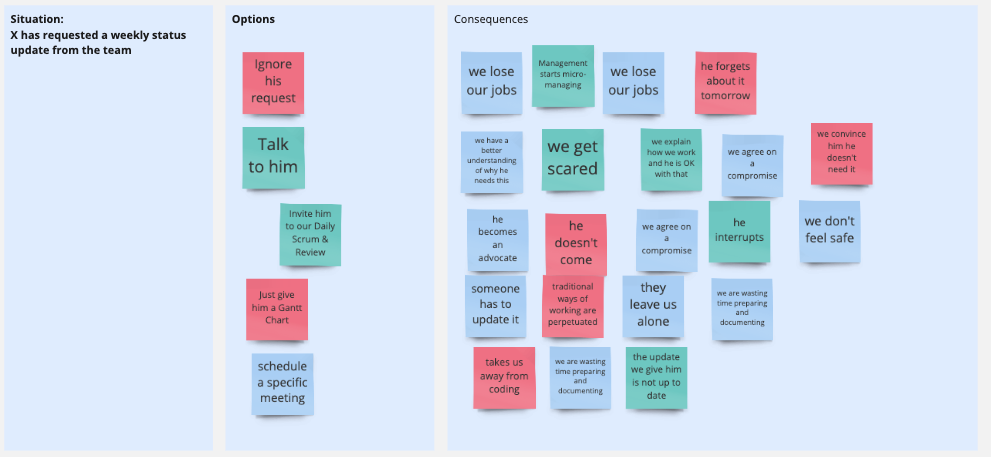
WHAT PROBLEM ARE YOU TRYING TO SOLVE?:
Teams that just go with the first Action Item they think of in a retro without considering other possibilities or the consequences of the one they picked.
SCENARIO
The team has had a lively retrospective conversation, complained about lots of stuff, reminded each other what a great team they are and now it is time for an action item. Unfortunately, they only spend a few seconds coming up with an idea and a few more agreeing to go with it. Of all the things they could do, why have they chosen this one?
Let’s say the problem is that someone on a higher floor has requested weekly updates. Noisy person on your team suggests that we schedule a meeting once a week to provide a status report. All in favour? yep, off you go to lunch.
You are biting your tongue because you have been here before and you know what the pitfalls are but you know your team needs to figure these things out for themselves. But how long is this experiment going to run before the team figures out that it is not a good idea? Sometimes you might need to step in and teach but before you do that, try to get them to think it through. If you can encourage the team to think about consequences before they try an experiment, they might not have to make every mistake for themselves.
THE ACTIVITY
This activity is not one I designed but I have been doing it for so long that I don’t know where it came from. Originally, it was introduced to me as a good activity for teenagers because teenagers are notoriously bad at thinking of consequences. I have repurposed it to use with Scrum teams.
DEFINE THE SITUATION
In my example, the situation is that someone has requested weekly updates. The situation is whatever came up in retro that you want to do something about.
BRAINSTORM OPTIONS
This is the part where I tell people to go wild. One option would be to ignore this person. One option would be to give up and quit your job. Make sure to also include things that you would actually consider doing. You could: Invite the person to your Daily Scrum and Reviews. Teach the person how to read your Burn-Up Chart and show them where it is. Talk to the person to truly understand what it is they need.
Ask everyone to do brainstorm a few options.
BRAINSTORM CONSEQUENCES
Do this together. I like to start with the crazy ones. Let’s say we ignore an important person, what could happen? Maybe they are the kind of person who will forget about it next week. Maybe this a toxic person and we know that he will go ballistic. Then what will happen?
The magic here is in the conversation. Once you have spent some time really thinking about the consequences, it’s much easier to pick an option. The team has agency, they can decide what they want to try. However, they are responsible for the consequences of selecting that option.
Scheduling a weekly meeting will cost you a lot of time. Talking to the individual is likely to result in a compromise. Now he knows where to see the information radiators that are already available to him so he can get the information he needs.
Here’s hoping your team will pick the option that is likely to result in the best consequences. If it doesn’t, you’ll have a topic for the next retro.